 W
WThe Bagridae are a family of catfish that are native to Africa (Bagrus) and Asia from Japan to Borneo. It includes about 245 species. These fish are commonly known as naked catfishes or bagrid catfishes.
 W
WBagrichthys is a genus of bagrid catfishes.
 W
WBagrichthys hypselopterus is a species of bagrid catfish found in Thailand, Indonesia and Malaysia. This species reaches a length of 40.0 cm and is commercially fished for human consumption.
 W
WBagrus is a genus of bagrid catfishes. These are relatively large catfish found in freshwater habitats in Africa, except for the virtually unknown B. tucumanus from South America, which likely is a synonym of Luciopimelodus pati.
 W
WBatasio is a genus of catfish of the family Bagridae. These small fish are found in fast-flowing hillstreams throughout South and mainland Southeast Asia.
 W
WCoreobagrus is a genus of bagrid catfishes found in Eastern Asia.
 W
WHemibagrus is a genus of catfishes of the family Bagridae.
 W
WHemibagrus microphthalmus is a species of catfish found in the Irrawaddy, Sittang and Salween rivers of India, Myanmar and Thailand.
 W
WHemibagrus nemurus is a species of catfishes of the genus Hemibagrus in the family Bagridae. After a major review by Ng and Kottelat (2013), its distribution is believed to be confined (endemic) to Java. It is found in Sumatra in the Bukit Tigapuluh National Park in 2016, too.
 W
WHemibagrus wyckioides, the Asian redtail catfish, is a species of catfish of the family Bagridae.
 W
WHorabagrus is a genus of catfish in the family Horabagridae endemic to rivers in the Western Ghats in Kerala and Karnataka, India. H. brachysoma is an important food fish and members of this genus can be found in the aquarium trade.
 W
WHyalobagrus is a genus of bagrid catfishes found in Southeast Asia.
 W
WHyalobagrus ornatus is a species of bagrid catfish found in Indonesia, Malaysia and Thailand. It is found in the Muar River drainage in the southern Malay Peninsula of Malaysia and Thailand and Kapuas basin in western Borneo. It occurs in streams and peat swamps.
 W
WThe kampango or kampoyo is a critically endangered species of large and predatory bagrid catfish that is endemic to Lake Malawi, Lake Malombe and the upper Shire River in Africa. It prefers areas near rocks in water shallower than 50 m (160 ft), but it also occurs deeper and over a sandy or muddy bottom.
 W
WMystus is a genus of fish in the family Bagridae native to Asia. Phylogenetic relationships within this genus are poorly understood, though it has been suggested that there are two major lineages.
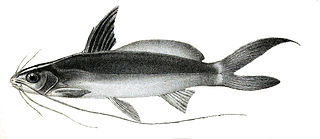 W
WMystus cavasius, the Gangetic mystus, is a species of catfish of the family Bagridae.
 W
WMystus gulio, the Long Whiskers Catfish, is a species of catfish of the family Bagridae. The generic name is probably derived from the Latin "mystax", meaning "moustache", due to the long barbels.
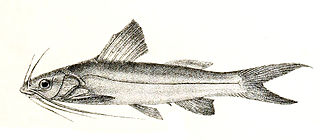 W
WMystus keletius, is a species of catfish of the family Bagridae. It is native to India and Sri Lanka.
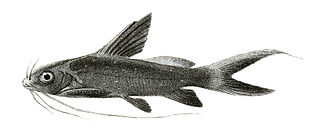 W
WMystus leucophasis is an Asian species of upside-down catfish belonging to the family Bagridae.
 W
WMystus nigriceps, the two-spot catfish, is a species of catfish of the family Bagridae. The species was available in aquarium circles without a scientific name until a connection was made to a description of Mystus micracanthus by the ichthyologist Bleeker, in 1846. The artist's impression at that time showed a catfish without any obvious markings, although another researcher in the early 1940s described it with two body spots. M. micracanthus is a junior synonym of M. nigriceps.
 W
WMystus vittatus, the striped dwarf catfish, is a species of catfish of the family Bagridae. It is found in brackish water systems with marginal vegetation in lakes and swamps with a mud substrate of Asian countries Pakistan, India, Sri Lanka, Nepal, Bangladesh and probably Myanmar. Populations of Southeast Asian countries is in debate, due to close morphological similarities among Mystus species in that region.
 W
WNekogigi is a species of bagrid catfish endemic to Japan where it is only found in Mie Prefecture on Honshu. It occurs in streams and can grow to a length of 10.8 cm.
 W
WOlyra is a genus of catfishes of the family Bagridae. This genus occurs throughout South Asia and western Indochina, from India to western Thailand.
 W
WOlyra longicaudata is a species of longtail catfish native to India where it occurs in Darjelling Himalaya in Assam, and Myanmar, where it occurs in Tenassarim. This species grows to a length of 11 cm (4.3 in) in standard length.
 W
WPelteobagrus is a genus of bagrid catfishes found in eastern Asia. The taxonomy of this genus is unclear and many authorities treat it as a junior synonym of Tachysurus and the type species of the genus, is Silurus calvarius which is a synonym of Tachysurus fulvidraco.
 W
WPseudobagrus is a genus of bagrid catfishes that inhabit streams and rivers throughout East Asia. About half of these species occur in China.
 W
WRama rama is a species of bagrid catfish endemic to India where it is found in the Brahmaputra River basin. It is the only member of its genus.
 W
WRama rama is a species of bagrid catfish endemic to India where it is found in the Brahmaputra River basin. It is the only member of its genus.
 W
WRita is a genus of fish in the family Bagridae found in South Asia. These species have a single pair of mandibular barbels, an elongated Weberian apparatus firmly sutured to the basioccipital and the sensory canal on the posttemporal enclosed with bone.
 W
WRita chrysea, or the Mahanadi rita, is a species of bagrid catfish endemic to India where it inhabits the Mahanadi River system in Orissa and Madhya Pradesh. It is found in rivers and large streams. Spawning occurs during the monsoon months. It grows to a length of 19.5 cm and is commercially fished for human consumption.
 W
WRita gogra is a species of bagrid catfish endemic to India where it is found in the rivers of the Deccan Plateau up to the Krishna River system. It is an inhabitant of large rivers. It grows to a total length of 26 cm and is commercially fished for human consumption.
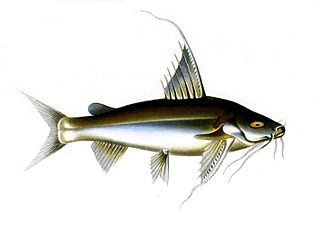 W
WRita kuturnee is a species of bagrid catfish endemic to India where it occurs in the rivers of the Deccan Plateau up to the Krishna River system. It is an inhabitant of large rivers. It grows to a total length of 30 cm and is commercially fished for human consumption.
 W
WRita rita is a species of bagrid catfish that is found across southern Asia. It has been recorded in Afghanistan, Bangladesh, India, Myanmar, Nepal and Pakistan. It is one of the giants of its genus, growing a length of 150 cm. It is commercially fished for human consumption.
 W
WRita sacerdotum, the Salween rita, is a species of bagrid catfish that occurs in Myanmar and Thailand where it is found in large rivers. It is the giant of its genus, reaching a length of 200 cm (79 in).
 W
WSperata seenghala, the Giant river-catfish, is a species of bagrid catfish. It is known locally as Guizza, Guizza ayer, Auri, Ari, Pogal, Singhara and Seenghala, among other names. It is found in southern Asia in the countries of Afghanistan, Pakistan, India, Nepal and Bangladesh with reports of occurrence in Myanmar, Thailand and Yunnan, China. It can reach a length of 150 cm, though lengths up to 40 cm are more usual. It is commercially fished for human consumption as well as being a popular gamefish with a reputation for being a good fighter when hooked. It is carnivorous in diet. It can be distinguished from other sperata species by its spatulate, blunt snout, relatively short barbels and mouth that is only 1/3 as wide as the head is long.
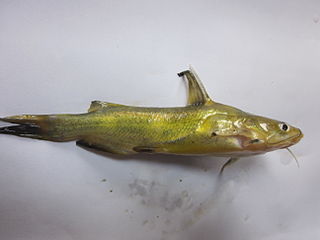 W
WTachysurus is a genus of bagrid catfishes found in eastern Asia. The currently recognized species in this genus are:Tachysurus argentivittatus (Regan, 1905) Tachysurus brashnikowi (L. S. Berg, 1907) Tachysurus fulvidraco (J. Richardson, 1846) Tachysurus herzensteini (L. S. Berg, 1907) Tachysurus hoi (Pellegrin & P. W. Fang, 1940) Tachysurus longispinalis (V. H. Nguyễn, 2005) Tachysurus nitidus (Sauvage & Dabry de Thiersant, 1874) Tachysurus nudiceps (Sauvage, 1883) Tachysurus sinensis Lacépède, 1803 Tachysurus spilotus H. H. Ng, 2009 Tachysurus virgatus (Ōshima, 1926)
 W
WTachysurus fulvidraco, the yellowhead catfish or Korean bullhead, is a species of bagrid catfish found in eastern Asia from Siberia to China, Korea, Vietnam, and Laos, where it can be found in lakes and river channels. It can reach a maximum length of 34.5 cm, weighing 3 kg, though it is much more commonly found to a length of 8 cm. It is a minor component of commercial fisheries.
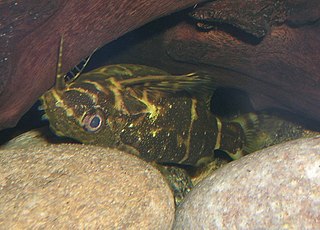 W
WThe name upside-down catfish is most commonly used by aquarists to refer to the mochokid catfish Synodontis nigriventris alternately known to ichthyologists as the blotched upside-down catfish or false upside-down catfish. However, a number of other fish may also be known by this name:Mystus leucophasis – Asian upside-down catfish Synodontis angelicus – spotted upside-down catfish Synodontis aterrima – sometimes sold as S. nigriventris in the aquarium trade, but in the past not identified as a separate species by retailers Synodontis batensoda=Brachysynodontis batensoda – known as giant upside-down catfish, or squeaker. Found in northern, northeast, and western Africa Synodontis contracta – big-nosed upside-down catfish, sometimes sold as S. nigriventris to aquarists, a species with which it is easily confused Synodontis nigrita – false upside-down catfish, very commonly sold as S. nigriventris in the aquarium trade and only recognised as a different species once the fish matures